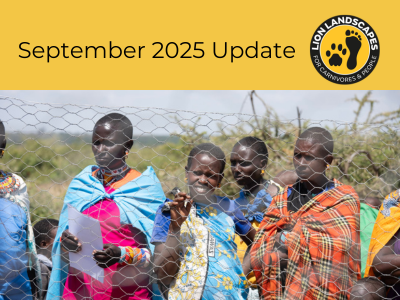Man-eating lions and the risks of relocation
- Amy Dickman and Alayne Cotterill

- Sep 28, 2021
- 5 min read
Updated: Apr 23, 2024
By Amy Dickman and Alayne Cotterill, joint CEOs, Lion Landscapes
“I held onto the tree all night long. I saw my brothers eaten by the lioness: it was very painful. It was all bones that I saw when I scaled down and ran away. I will never be happy again without my brothers.”
This is the heart-breaking account of Kiambwa Lekitony, an 11-year old Tanzanian boy who recently witnessed a lion killing and eating his three brothers after they went into the bush to search for lost cattle. Only the skulls of the 9 and 10 year old boys were left. Kiambwa himself was badly injured, as well as traumatised by a horrific incident that none of us would surely wish on anyone.
Despite the charisma and value people ascribe to lions globally, this can be the devastating reality of living alongside them for rural people. The international public often seem unaware that across much lion range, lions rely on human-dominated land around and beyond Parks. Lions live where communities live, work and have deep roots. People in these places often simply have no choice but to fetch firewood and water, tend livestock and walk to school, all in the knowledge that they might risk attack.
The camera traps caught this sequence of a pastoralist with cattle and then three minutes later a lion. Luckily the pastoralist was vigilant and there were no attacks.
Given the extensive overlap, lion attacks on people are relatively rare, but still far more common than most people imagine. Between 1990 and 2007, lions attacked over 1000 people in Tanzania. Most attacks were unprovoked, with lions entering farms, settlements and even houses to attack people. Nearly a fifth of attacks involved children under 10 years old. Each and every attack is a tragedy.
The depth of loss is often shockingly dismissed by people seeing it through the safety of a faraway screen, but is very real. We have sat with families devastated by the killing of their children. We have felt shame when they assume we discount their terrible loss, and think we prioritise lion lives over those of their children. Having seen our own children in the bush, and often feared for their safety, it seems impossible that people would ever risk their own children to save lions. And if we wouldn’t risk our own children, it is unconscionable that we should risk other peoples’ children.
The appropriate response to a lion attack on a human is to identify and track the animal responsible, and then to humanely kill it. Similar actions are taken in other places where people encounter dangerous predators. Recently in the US, a 16-year old girl sleeping in a hammock during a trip to a National Park was attacked by a black bear, which was promptly killed. In the UK, the risk from an escaped Eurasian lynx (a species not known for killing people), was deemed severe enough to kill the animal after recapture attempts failed. If wild carnivores cannot be allowed to risk the lives of Europeans or Americans, then the risk to African lives should be viewed no differently.
However, recent reports suggest that the plan is to relocate, not kill, the lion involved in Kiamba’s attack. That has generated support, particularly on social media from people concerned about declining lion populations. Unfortunately, relocation in cases like this is likely to increase risks to lions and other wildlife, further intensifying decline, as well as posing unacceptable risks to local people.
Conflict with local people has been identified by experts as the primary threat to lions, and relocation is often likely to directly increase that threat. Locally, if rapid steps are not taken to identify and kill a man-eating lion, people perceive that local lives are less valued than lion lives. That rightly intensifies feelings of deep injustice and conflict. People are then much more likely to take matters into their own hands, indiscriminately poisoning and killing far more animals than just the one responsible. This has devastating conservation and welfare impacts. As well as the unacceptable risks to people, it is simply not worth saving one lion’s life to amplify and embed the conflict which threatens so many other lions.

An indiscriminate poisoning incident killing lions and vultures.
So if a lion must be removed, what are the options? One is permanent captivity, but that is likely to involve far more long-term stress for a wild lion than a quick death. Even relocation involves substantial stress from capture, travel and release. And where to release it? Acceptable sites would need to be far from people, as it would be deeply unethical to put other lives knowingly at risk. But how far is far enough? Lions and other big cats can move long distances after relocation, and often keep causing conflict. Suitable locations should also ideally lack existing lion populations or major threats, but have sufficient habitat and prey. Such areas are vanishingly few. In reality, lions often end up in areas with people, resident lions and conservation threats, putting both people and lions at increased risk of death.
The pressure to relocate rather than kill seems to be driven by media and social media pressure, where the killing of an iconic animal like a lion seems increasingly untenable to Western audiences. But relocation often does lead to deaths, frequently in worse ways than a professional’s bullet. Of 13 conflict-causing lions translocated and monitored in Botswana, 10 died within a year, including five killed by people because of conflict. Negative attitudes towards carnivores can be both ‘contagious’ and long-lasting, so if you experience a carnivore attack, you are more likely to view other negatively as well, and that hostility can last for years. Given the primacy of conflict as a threat to lions, it is imperative that we don’t simply move problems and inadvertently create yet more conflict.
In some limited circumstances, lion relocation can be both appropriate and effective. But for man-eating lions, the risks to both humans, lions and wider wildlife are simply not worth it. There are many situations in conservation where costs and benefits are finely balanced, where what is best for lions and for local people clash, and where decisions are legitimately difficult. Choosing between killing a man-eating lion, or risking more devastating impacts on lions and other wildlife – and most importantly on families like Kiambwa’s - is simply not one of them.
Stay in touch
You can visit our website and keep up to date on our work and research in Africa by subscribing to our general newsletter. Join us on Facebook, Instagram, Twitter and LinkedIn for recent photos and stories from the field.
.png)







Comments